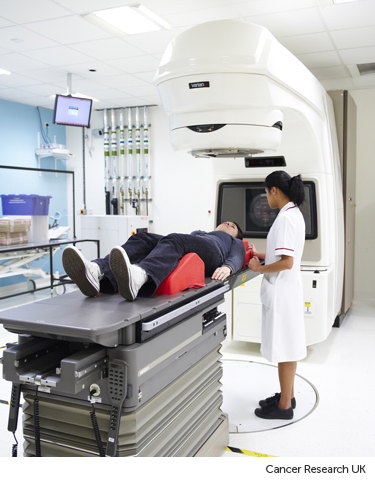Radiotherapy to relieve pressure or a blockage
Cancer can block passages in the body, such as the windpipe (trachea), or put pressure on organs or nerves. This can be painful and can cause other symptoms.
Radiotherapy can help to shrink the cancer and relieve symptoms when this happens. It won't cure your cancer but can make you feel better and give you a better quality of life for a longer time.
Blockages
Cancer growing into passages can cause some problems. This includes cancer in the:
- food pipe (oesophagus) - which can cause difficulty swallowing
- bowel - this can stop waste from passing out of your body and make you constipated
- wind pipe (trachea) - which can make it difficult to breathe
Nerve pain (neuropathic pain)
Cancer pressing on your nerves can cause pain. It is usually more difficult to treat than other types of pain.
People often describe nerve pain as a burning feeling. Or as if something is crawling under their skin. Nerve pain is usually in one area of the body.
Pain from pressure on a body organ
Your cancer may press on an organ. For example, a cancer in the bowel may press on your stomach or liver.
Cancer that has spread to the liver can cause pressure on the fibrous covering of the liver itself. There are nerves in this membrane and it can be quite painful.
Treatment
External beam radiotherapy
You have your treatment in the hospital radiotherapy department, usually as an outpatient.
You might have 1 treatment or a number of treatments given over a few weeks. These treatments are sometimes known as fractions. This depends on the type of cancer. You are most likely to have a short course of a few treatments over a few days.
The radiotherapy machine is called a linear accelerator. To have treatment you lie on the radiotherapy couch. You will be in the same position that you were in when your treatment was planned. The therapeutic radiographers help you to get into the right position. They put on any moulds that you might need.

Once you are in the right position your radiographers leave you alone in the room. This is so they are not exposed to radiation during the treatment. They can see and hear you the whole time.
It is important that you keep still and breathe normally. Sometimes there may be a delay in starting the radiotherapy. This is due to the radiographers taking an x-ray before treatment to check your position.
It can be uncomfortable to lie very still during the treatment. This is because the radiotherapy couch can be quite hard.
Internal radiotherapy
You might have a type of internal radiotherapy called brachytherapy. It can help to control cancers in some parts of the body. This means a small radioactive material is put into or near the cancer to destroy the cancer cells.
For example, to treat a tumour in your food pipe (oesophagus), you first have a tube put down your nose. This then goes into your food pipe. This is known as a nasogastric or NG tube.
Using a scan, the doctor positions the NG tube next to the cancer. They then connect the tube to the brachytherapy machine and leave the room. They can see and hear you the whole time.
The machine contains a small radioactive metal ball which travels into the tube. This treatment gives a high dose of radiotherapy directly to the cancer. Very little radiation reaches the surrounding healthy tissues. The treatment lasts a few minutes.

Once the treatment is finished, the radioactive metal goes back into the machine. Your radiographers come in and remove the tube from your food pipe.
Possible side effects
This type of radiotherapy doesn't usually cause many side effects and they tend to be mild. The side effects tend to come on as you go through your treatment course. They may last for a week or two after the treatment has ended.
You might feel more tired than before the treatment started.
If you have external radiotherapy your skin may go red in the treatment area.
You may feel sick if your stomach is in the treatment area. To help control this, your doctor or nurse can give you anti sickness medicines (anti emetics). You might find that it helps to take an anti sickness tablet 20 minutes before your treatment.
If your bowel is in the treatment area, you might have some diarrhoea. Your doctor or nurse can give you some medicines to help control diarrhoea.



